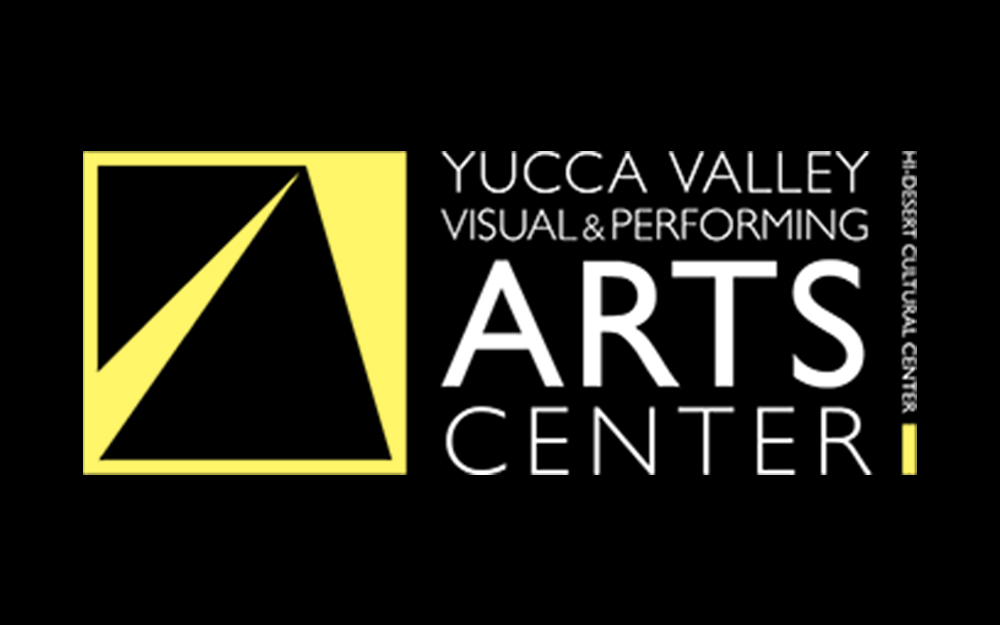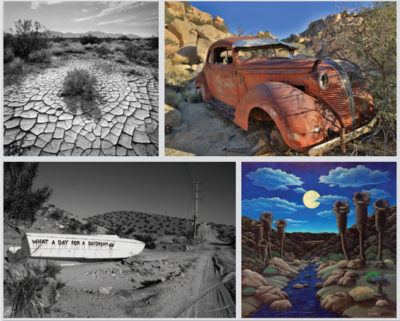
By Angela Romeo
Desert Icons, curated by Michael McCall, is at The Yucca Valley Visual & Performing Arts Center, located at 58325 Highway 62, Yucca Valley, California. The exhibition challenged artists to present the desert as they see it – through their daily lives and work. It runs through October 21. Last week we highlighted the work of several artists. This week we continue.
When one thinks of an iconic desert figures Snake Jagger comes to mind. Snake cuts a colorful character and his distinctive style, Whimsical Surrealism, exudes his passion and love for the desert.
“Desert Icon – it is an honor to be considered one. I have lived and worked in this area for over 40 years, so I may have earned that title, just a little bit,” smiled Snake. “I was approached by Michael to be involved in this show at the Yucca Valley Arts Center. I was convinced that this new venue was a game changer for the high desert. Michael choose from a variety of paintings I had. These are his choices and I agree with him.”
“The diversity in this show is a wonderful commentary on the diversity of the creative minds that inhabit this inspirational environment. And at the same time there is much that pulls us all together as creative people, doing what we love to do, and making statements at the same time.”
“With my work, my message has always been that we are the stewards of this planet. It is up to us to care for and protect our little blue marble in space.”
Photographer Dan Bartlett sees the desert through the eye of lens. “I have a great love for the desert and all the beauty and weirdness it holds,” stated Dan. “The Yucca Valley Arts Center is fantastic! Michael and all others involved did an outstanding job putting this show together.”
“My work, What A Day For A Daydream, is an unfortunate desert icon in the sense that it literally someone’s junk. I embrace it by portraying it as art. I challenge the term icon by showing a photo of a boat in the desert.”
“Each artist’s unique approach to the theme makes this show special. The different styles pooled together complement each other and make this show interesting and appealing. I hope that the works will leave visitors with a new outlook and greater appreciation for our incredibly beautiful desert and the fascinating icons that are a big part of it.”
What attracted curator Michael McCall to this project?
 “Once I was asked to design the exhibitions for the first year of the gallery, I went about planning and building a show of hi-desert artists that represented how the environment influences their choices. I wasn’t interested in pretty pictures. I wanted to experience their collective imagination and see how they can stretch from the seen into the unforeseen. Humor and insight were going to trump pedantic and scholastic concerns in this one. So, I went looking for the unusual.”
“Once I was asked to design the exhibitions for the first year of the gallery, I went about planning and building a show of hi-desert artists that represented how the environment influences their choices. I wasn’t interested in pretty pictures. I wanted to experience their collective imagination and see how they can stretch from the seen into the unforeseen. Humor and insight were going to trump pedantic and scholastic concerns in this one. So, I went looking for the unusual.”
But what makes something desert and an icon? “Good question…The repeated use of an image creates the icon in our minds. If you look into it, the Saguaro Cactus is the accepted icon of the North American desert continent. Yet that species of cacti is not native to the Mojave Desert, but the Joshua Tree is. My quest was to definitely challenge the accepted icon of the hi-desert region.”
“How many times do I see a pretty picture of a sunset with a Joshua Tree in the foreground? Too many. You will see a few Joshua Trees in the Desert Icons exhibition… a few, but only in context to another idea.”
“For me, curating a show entitled something as broad as Desert Icons was going to bring me a diverse group of artists. That’s how I work. I wanted diversity and especially in the images, which meant I had to go to their studios and look for myself. When you ask an artist to submit an image for reference, they send something they either like a lot or something they think I’m going to like. I wanted to look through the stacks, into the corners, find out how diverse their own output is, and that is what I did.”
“Words help us to understand… but they are limited in definitions. Definition by its nature does not allow much room for our emotions to live and expand. Images have the ability to allow us to wander, to receive and come to conclusions without being told how to. I want the viewer to travel into this exhibition and feel it… feel the desert, the oddness of it all. I wanted not only the artists, but also the viewer to expand a bit in determining what an icon might be and in particular what a desert icon might be. That freedom I hope is perceived when you walk through the show, when you first enter through the arched portal I constructed that leads the viewer into the exhibition. We live in a world so torn and conflicted, I want people to enjoy their diversity, their own vision and perceptions. Stand at the portal and have your photograph taken, and you can simultaneously be a desert icon while you look at them.”
With this exhibition Michael McCall has cemented The Yucca Valley Visual & Performing Arts Center place in the rich art community of the HI Desert.
The Exhibition runs through October 21. For more information visit hidesertculturalcenter.org










































